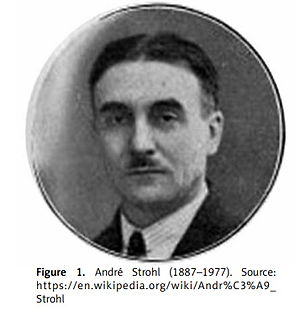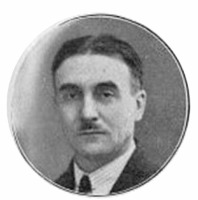The increasing incidence of Guillain-Barré syndrome (GBS) during the coronavirus disease 2019 pandemic prompts a discussion concerning the correct form of the eponym and the reasons for omitting André Strohl [1]. André Strohl (Figure 1) was born on March 20, 1887 in Poitiers in west-central France. Initially, Strohl began medical studies, later switching to mathematics, physics and chemistry. Afterwards, he returned to study medicine at the University of Paris and in 1913 defended his medical doctorate thesis [2]. During World War I (WWI), Strohl served in the French army at his request and was assigned to perform radiological examinations. The military service did not suppress his scientific work, which was reflected in 1916 when he used a radiological imaging technique to locate a bullet in the body of a wounded person [2]. In the same year, together with two neurologists working in the Sixth French Army neurological unit, Georges Guillain (1876–1961) and Jean-Alexandre Barré (1880–1967), he described one of the most recognized neurological syndromes in the history of neurology [3]. On 13 October 1916, during a meeting of members of the Société de Neurologie of the French Army, Guillain, Barré and Strohl presented two French soldiers, aged 25 and 35, who had developed progressive acute motor weakness of all limbs, more pronounced distally with mild sensory disturbances, loss of tendon reflexes, preserved skin reflexes and no sphincter disturbances [3]. Although the clinical features were similar to 10 patients with “acute ascending paralysis” reported half a century previously by Jean Landry (1826–1865), two of whom died, the 1916 publication was clearly distinguished by the use of additional tests [3–5]. The authors applied lumbar puncture which revealed increased concentration of the cerebrospinal fluid (CSF) protein with normal cell count, neurological examination of tendon reflexes and novel myographic studies [3]. Strohl is commonly credited with carrying out the electrophysiological tests for the 1916 publication. His findings in the form of extreme delayed myographic curves with reduced speed and amplitude remain an important part of the manuscript and constitute a prelude to identifying peripheral demyelination as the major underlying process [3, 5]. By combining the clinical, laboratory and electrophysiological hallmarks, the observations presented by Guillain, Barré, and Strohl have withstood the test of time and remain still valid in the diagnosis of an acute inflammatory demyelinating polyradiculoneuropathy (AIDP). However, after the publication, the authors constantly had to confirm the uniqueness of their remarks and list the clinical features that distinguish it from previous case reports. Guillain and Barré, who soon became friends, were particularly active in these confrontations, pointing to a specific neurological symptomatology, favorable prognosis and no CSF inflammation in the patients they described. Interestingly, neither of them mentioned Strohl as a co-author when providing further case studies in their subsequent publications [6]. Furthermore, in 1927, Draganesco and Claudian introduced the eponym of GBS to denote AIDP for the first time in the literature, omitting Strohl’s name and falsifying the bibliographic entry of the 1916 paper [7]. Despite the passage of time, the real reasons for Strohl’s ostracism are shrouded in mystery. The literature provides several possible explanations for this omission [5, 8]. Among them, it is stated that Strohl was not the neurologist, his participation was limited to myographic but not clinical aspects and that he was the youngest of the co-authors at the time of publication (29 years). However, these arguments seem debatable as all of them were known to both Guillain and Barré and were not an obstacle at the stage of preparing the paper. In 1916, both Guillain and Barré were experienced neurologists (40 and 36 years old, respectively) and had well-known mentors (Pierre Marie and Joseph Babiński, respectively), which placed them favorably in the neurological community [6]. They also knew that Strohl, as a radiologist and electrophysiologist, could not be known in the neurological society, but his extra-neurological skills allowed the diagnostic panel of the 1916 paper to be expanded. In the discussion section, the authors stated that the graphic method assessed the tendon reflex more precisely than an examination with the hammer [3]. Interestingly, some researchers suggest a possible political context for dropping Strohl’s name from the eponym. Strohl’s parents came from Alsace – a heavily German province in France, his surname was German and his mentor, Professor Weiss, was also of Alsatian origin [2, 5]. All of the above could have made Strohl a victim of the anti-German mood prevailing in France at that time. Nevertheless, by joining the French army during WWI at his own request, despite fragile health, Strohl definitely proved his patriotism. There are also opinions that an eponym with three surnames would simply be too long and less practical in everyday use [5]. However, the adoption of such an assumption would question the validity of using other tripartite eponyms, e.g. Charcot-Marie-Tooth disease. It is worth considering whether Strohl wanted to participate in the clashes between clinicians and to what extent he agreed with the views of Guillain and Barré on discrediting Landry’s case reports. Importantly, Landry originally identified three possible clinical variants of the disease course by distinguishing ascending paralysis without sensory signs and symptoms, ascending paralysis with concomitant ascending anesthesia and analgesia or progressive generalized polyradiculoneuritis. Moreover, he significantly increased the value of his manuscript by providing autopsy findings that revealed no spinal cord involvement [4, 5, 9]. Therefore, Jean Landry was a clinical precursor of AIDP description and some neurological authorities recommend the inclusion of his surname to define the eponymous quadripartite as Landry-Guillain-Barré-Strohl syndrome [5, 9, 10]. Notably, in the 1916 paper, none of the described patients had recent infections, and the older one had a skin rash, muscle hypertonia with an inability of complete relaxation, intermittent myoclonic jerks and difficulty in mouth movements, which does not comply with the globally accepted criteria for AIDP diagnosis [11]. In 1924 Strohl gained a doctorate in physics and in 1926 he was named professor of physical medicine of the Faculty of Medicine in Paris, where he worked until his retirement in 1957 [2]. Over time, there have been reports of AIDP patients with moderately elevated cytosis in CSF, cranial nerve involvement or a fatal course [6]. Therefore, the role of clinical presentation itself as well as CSF assessment declined, and the value of electrophysiological studies began to increase. In 1938, Guillain was forced to accept the arguments of his opponents and expand the possible clinical symptomatology of the syndrome [12]. In the same year, reports were published in which the eponym was used with the names of all three co-authors, thus emphasizing Strohl’s important contribution to the 1916 paper [13, 14]. Furthermore, the use of myographic tests in the diagnostic approach of GBS introduced by Strohl provided the basis for the subsequent extension of the electrophysiological patterns of the syndrome. In 1986 Feasby et al. described 5 patients with a clinical diagnosis of GBS but with the predominant axonal degeneration of peripheral nerves in electrophysiological studies. The authors proposed that these patients represented an axonal variant of the disease [15]. Currently, electrophysiological tests make it possible to distinguish GBS subtypes such as AIDP, acute motor axonal neuropathy and acute axonal sensory and motor neuropathy [16]. Thus, the electrophysiological studies entrusted to Strohl at the stage of preparing the 1916 paper are still an inseparable component of GBS diagnostics. André Strohl died on 10 March 1977 [2]. His significant contribution to the 1916 publication and the introduction of myographic studies in the diagnostic approach of AIDP should be crowned with the use of his name in the eponym of the syndrome. Currently, the eponym composed of two surnames is still most often used, thus maintaining Strohl’s ostracism [17]. However, despite the controversy caused by Strohl’s omission, the use of the tripartite eponym (Guillain-Barré-Strohl syndrome) continues to be fully valid [18]. Therefore, we strongly encourage the common use of Guillain-Barré-Strohl syndrome instead of GBS.
Current issue
Archive
Manuscripts accepted
About the Journal
Editorial office
Editorial board
Section Editors
Abstracting and indexing
Subscription
Contact
Ethical standards and procedures
Most read articles
Instructions for authors
Article Processing Charge (APC)
Regulations of paying article processing charge (APC)
NEUROLOGY / LETTER TO THE EDITOR
Guillain-Barré or Guillain-Barré-Strohl syndrome: medical and non-medical reasons for omitting Andre Strohl from the eponym
1
Department of Neurology, 10th Military Research Hospital and Polyclinic, Bydgoszcz, Poland
2
Sanitas – Neurology Outpatient Clinic, Bydgoszcz, Poland
3
Department of Ophthalmology, University of Warmia and Mazury, Olsztyn, Poland
4
Institute for Research in Ophthalmology, Foundation for Ophthalmology Development, Poznan, Poland
Submission date: 2022-03-29
Final revision date: 2022-06-05
Acceptance date: 2022-06-05
Online publication date: 2022-06-23
Publication date: 2022-07-01
Corresponding author
Łukasz Rzepiński
10th Military Research Hospital and Polyclinic, Department of Neurology, Powstańców Warszawy 5, 85-681, Bydgoszcz, Poland
10th Military Research Hospital and Polyclinic, Department of Neurology, Powstańców Warszawy 5, 85-681, Bydgoszcz, Poland
Arch Med Sci 2022;18(4):1127-1129
TOPICS
REFERENCES (18)
1.
Boneschi FM, Colombo A, Bresolin N, et al. Covid-19-associated Guillain-Barré syndrome in the first wave of COVID-19 pandemic in Lombardia: Increased incidence or increased seroprevalence? J Neurol Sci 2021; 429: 117794.
2.
Desgrez H. André Strohl (1887-1977). Bulletin de l’Académie nationale de médecine. 1977; 161: 563-71.
3.
Guillain G, Barré JA, Strohl A. Sur un syndrome de radiculonévrite avec hyperalbuminose du liquide céphalo-rachidien sans réaction cellulaire. Remarques sur les caractères cliniques et graphiques des réflexes tendineux. Bull Mém Soc Méd Hôp Paris 1916; 40: 1462-70.
4.
Landry O. Notesur la paralysie ascendante gigue. Gazette Hebdomadaire 1859; 6: 472-4.
5.
Waclawik AJ. The Legacy of the Seminal Publication by Guillain, Barré, and Strohl: The History Behind the Eponym. WMJ 2018; 117: 160-3.
6.
Uncini A. Guillain-Barré syndrome: what have we learnt during one century? A personal historical perspective. Rev Neurol 2016; 172: 632-44.
7.
Draganesco H, Claudian J. Sur un cas de radiculu-névrite curable (syndrome de Guillain-Barré) apparue au cours d’une ostéomyélite du bras. Rev Neurol 1927; 2: 517-21.
9.
Afifi AK. The Landry-Guillain-Barré Strohl syndrome 1859 to 1992 a historical perspective. J Family Community Med 1994; 1: 30-4.
10.
Ropper AH, Wijdicks EFM, Truax BT. Guillain-Barré Syndrome. F.A. Davis Co; Philadelphia, PA 1991; 3-17.
11.
Leonhard SE, Mandarakas MR, Gondim FAA, et al. Diagnosis and management of Guillain-Barré syndrome in ten steps. Nat Rev Neurol 2019; 15: 671-83.
12.
Guillain G. Synthèse générale de la discussion. J Belge Neurol Psy 1938; 38: 323-9.
13.
Gautier P, de Morsier G, Bron A. Le syndrome de Guillain, Barré et Strohl chez l’enfant. Revue Française de Pédiatrie 1938; 14: 247-52.
14.
Riser M, Planques M. Les polyradiculonévrites aigües (syndrome de Guillain-Barré et Strohl). J Belge de Neurol et Psychiat 1938; 38: 264-74.
15.
Feasby TE, Gilbert JJ, Brown WF, Bolton CF, Hahn AF, Koopman WF. An acute axonal form of Guillain-Barre polyneuropathy. Brain 1986; 109: 1115-26.
16.
Rajabally YA, Durand MC, Mitchell J, Orlikowski D, Nicolas G. Electrophysiological diagnosis of Guillain-Barré syndrome subtype: could a single study suffice? J Neurol Neurosurg Psychiatry 2015; 86: 115-9.
17.
Shi P, Nian D, Qu H, et al. Pathogenic mechanism of intestinal microbiota involved in Guillain-Barre syndrome and with Bifidobacterium intervention. Arch Med Sci 2021. doi: 10.5114/aoms/128103.
18.
Diez-Porras L, Vergés E, Gil F, Vidal MJ, Massons J, Arboix A. Guillain-Barré-Strohl syndrome and COVID-19: case report and literature review. Neuromuscul Disord 2020; 30: 859-61.
Share
We process personal data collected when visiting the website. The function of obtaining information about users and their behavior is carried out by voluntarily entered information in forms and saving cookies in end devices. Data, including cookies, are used to provide services, improve the user experience and to analyze the traffic in accordance with the Privacy policy. Data are also collected and processed by Google Analytics tool (more).
You can change cookies settings in your browser. Restricted use of cookies in the browser configuration may affect some functionalities of the website.
You can change cookies settings in your browser. Restricted use of cookies in the browser configuration may affect some functionalities of the website.




